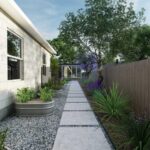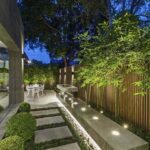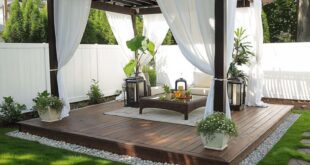Side yard landscaping often gets overlooked in favor of focusing on the front or backyard, but it can actually be an important area to spruce up. A well-designed side yard can not only enhance the overall aesthetic of your property, but also provide additional outdoor living space and improve curb appeal. With some strategic planning and creativity, you can transform your neglected side yard into a beautiful and functional extension of your home.
One of the key considerations when landscaping a side yard is the size and shape of the space. Side yards are typically narrow and may have constraints such as fences, utility boxes, or air conditioning units that need to be worked around. It’s important to carefully measure the dimensions of your side yard and take note of any obstacles that might affect the layout of your landscaping design. By understanding the limitations of the space, you can better plan for how to maximize its potential.
When it comes to choosing plants for your side yard landscaping, opt for low-maintenance options that can thrive in the conditions of the space. Consider factors such as sunlight exposure, soil quality, and climate when selecting plants. Dwarf shrubs, ornamental grasses, and ground cover plants are great choices for side yards that may have limited sunlight or space. Incorporating a mix of foliage textures and colors can add visual interest and create a lush, inviting atmosphere.
Incorporating hardscaping elements such as pathways, patios, or retaining walls can help define the layout of your side yard and create functional outdoor living spaces. By strategically placing these features, you can create a sense of flow and connectivity between different areas of your yard. A well-designed pathway can guide visitors through the space and draw attention to focal points such as a garden bed or seating area. Consider using materials that complement the aesthetic of your home, such as natural stone or brick, to tie the design together.
To add privacy and seclusion to your side yard, consider installing a fence or planting tall hedges along the boundaries. This can create a private retreat where you can relax and unwind without feeling exposed to your neighbors or passersby. Using trellises, arbors, or lattice panels can also provide additional screening while adding a touch of charm and character to your side yard. By incorporating these privacy-enhancing elements, you can create a cozy and intimate outdoor oasis that feels like an extension of your indoor living space.
When designing your side yard landscaping, don’t forget to consider functional elements such as lighting, irrigation, and drainage. Proper lighting can enhance the ambiance of your outdoor space and allow you to enjoy it well into the evening hours. Installing a sprinkler system or drip irrigation can ensure that your plants receive the water they need to thrive, while proper drainage solutions can prevent water pooling and erosion issues. By addressing these practical considerations, you can create a side yard that is not only beautiful but also sustainable and easy to maintain for years to come.

















